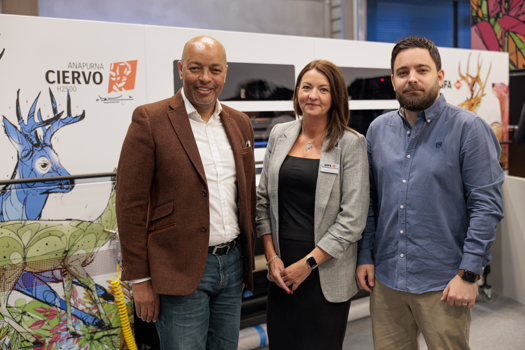Current president of the charity and guest speaker at the event, Prince Andrew emphasised the importance of ensuring that these skills don’t die out.
He told guests: “The more you can do to encourage young people to become skilled, particularly in your sector, which covers a wide range of skills, the better.”
A number of industry initiatives that aim to encourage young people to consider print as a career choice are already in place, but with the current average age in the industry at 48, many agree that more still could be done.
The Stationers’ Company sponsors The Crown Woods College in Greenwich, the first academy in the UK to specialise in digital media.
The academy aims to help prepare students to work in the digital economy across a broad range of digital skills, including print.
“Young people are absolutely vital to the future of the industry but it is still hard to persuade businesses to invest in training them,” says Stationers’ Company clerk William Alden.
“If we’ve got young people coming out of the Stationers’ Academy with an understanding of the digital world and digital printing then some of them are going to want to work in those industries and train and develop themselves.”
Charity Proskills’ PrintIT! Initiative aims to inspire students by enabling them to design a print-based product from start to finish and arranging school visits.
Furthermore, the PrintIT! brochure, which is worked on in conjunction with The Printing Charity and sent out to schools, aims to educate young people about apprenticeships and other opportunities in the industry.
The Printing Charity also promotes print to young people in a number of other ways. Its annual Print Futures Awards aim to help fund any costs associated with a relevant training course in printing, publishing or graphic arts.
The annual awards programme offers cash grants of up to £1,500 to UK residents aged 16 to 30.
“The industry has an ageing demographic and it will literally die if we don’t get some young people in,” says Stephen Gilbert, chief executive of The Printing Charity.
“This is an amazing and vital industry for the whole of the country and it contributes an awful lot in terms of GDP and jobs. It’s innovative and it’s one that we need to keep, nurture and see thrive.”
Gilbert says one difficulty is that many smaller print firms have limited opportunities to take on additional people or to engage with schools and colleges.
Apprenticeships are the route that many young people currently take to enter the industry.
The BPIF helps many young people to take their first steps into the industry by designing and delivering apprenticeships both in-house and helping to place apprentices at print businesses.
The government offers financial incentives to employers to persuade and help more businesses to offer apprenticeships.
“For those aged 16 to 18 years old, the government provides a 100% apprenticeship grant, which reduces to 50% for 19-to-23-year-olds,” says Proskills chief executive Jonathan Ledger.
“There’s also extra cash assistance via the Age Grant for those taking on apprentices for the first time.”
But Gerald Glover, creative director at Noted in Style, says some young people interpret apprenticeships as a way for firms to get cheap labour.
“I think there’s a lack of understanding about what the system can offer them because a lot of young people are looking short term and not long term.
“Businesses should be invited to go in and actually educate schools, especially those students that might be more practically minded than academic, or those that feel that they don’t want to go to university or can’t.”
Gilbert adds: “Getting young people to think about the industry is a challenge because they have a view that it’s about heavy and dirty machinery and is only for men. But it’s incredibly high-tech and clean and there are opportunities for both boys and girls.”
The key, then, could be in schools partnering more with printers to offer work experience placements, to give young people a taste of the industry and help them to understand the variety of options available to them in print.
Valuable experience
The government ended compulsory work experience placements for schools in 2012, meaning opportunities for students to have a taster of the workplace before leaving school have become smaller.
But a recent British Chambers of Commerce survey of more than 3,500 business bosses and education leaders found that 79% of employers believe work experience to be the most important activity to equip young people with workplace skills.
Retaining the young people that do enter print is another challenge faced by the industry.
“Keeping young people in print is tough because apprentice rates are not great, so there is an issue with cash,” says Gilbert.
“And the other difficulty is that, while the job losses have appeared to stabilise, there are still firms going under. So you get young people into the industry and fired up and enthusiastic about it and suddenly the world crashes around them.”
While a number of industry bodies and charities are already doing what they can to promote print to young people, they require the help and support of printers and others in the industry.
The more that young people are informed and educated about the raft of opportunities available in print, the more likely it is that the attention of young talent will be captured before it is diverted elsewhere.
OPINION
Print must do more to draw in the younger generation
 Jonathan Ledger, chief executive, Proskills
Jonathan Ledger, chief executive, Proskills
Anyone who left school, college or university in the 80s or before would have found it easier to try out a few industries until they found the one they liked and wanted to work in.
Schools are obliged to give careers advice, but limited budgets make this difficult to deliver. So young people are blindly encouraged to continue on through sixth form and go on to college or university.
Sadly, just 7% of the print industry’s workforce is under 25 years old – which is less than half the national average – and even worse, a shamefully tiny number of these are under 18 years old. This is because of unclear legislation relating to the school leaving age and to the hours young people can work. Schools are paid for full classrooms and so have no incentive to push students into work.
Advancing technology, innovation and changing job roles have made the industry harder to enter. The recent economic climate has compounded this by squeezing the purse of employers, leaving many unable to afford new entrants.
Young people do not have to stay in full-time education until they are 18 years old. Staying in ‘education’ can mean working while learning skills and earning a wage, instead of accumulating student debt. This could be a job with training or an apprenticeship.
Print employers can make a hugely positive difference to their businesses and young people by partnering with local schools to offer industry taster days or give group tours or assembly talks.
Of course you don’t have to do this on your own – Proskills’ PrintIT! links companies to schools already while the BPIF and a range of other training providers can help with taking on apprentices.
Employers need to do much more to inspire young people to enter print before they go off to university to accumulate student debt, or the best talent is attracted into industries other than print. So what are you waiting for?
READER REACTION
How important is it that the industry woo young workers?
 Nick Fincher, business development director, Emmerson Press
Nick Fincher, business development director, Emmerson Press
“Young people are crucial to the future of the print industry and I don’t think enough is currently being done. I think apprentices should be rewarded a lot better rather than paying the miniumum wage. A lot of kids will just go and work in a supermarket, do some overtime and make their money up that way while they decide what they want to do. Many who do go to university come out and then apply for roles but don’t get taken on by employers because they’ve got no experience.”
 Max Middleton, managing director, Snows Business Forms
Max Middleton, managing director, Snows Business Forms
“We were conscious that traditional print sectors are not always attractive to young people and concluded that the best way forward was to offer an apprenticeship. During the process we did come across the stereotypical candidates who “aren’t bothered” but our apprentice, Stephen, has been enthusiastic and wanted to learn and do his best, which has had a positive impact throughout the firm. The experience has been a big success for us and Stephen, whose achievement was recognised at the PrintWeek Awards.”
 Terrye Teverson, managing director, KCS Print
Terrye Teverson, managing director, KCS Print
“Schools seem to concentrate on academic achievements and those going to university. They don’t appear to look beyond university and jobs that their pupils may end up with. The ones that don’t go to university are not aware of print as an industry. Print has been sidelined as a thing of the past instead of embraced as working alongside technology. We have staff here now working with algorithms! Young people are the future workers in our industry and we need to show schools the possibilities in coming to work with us.”










